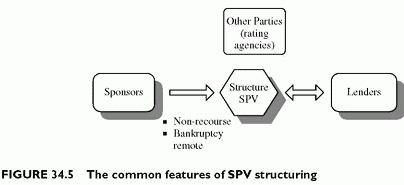STRUCTURED FINANCE AND SPV
Category: Risk Management in Banking
Another situation where credit risk measurement raises technical and specific difficulties is structured finance. Many structured finance transactions use Special Purpose Vehicles (SPVs). As their name indicates, these are dedicated entities to a special operation. SPVs serve in numerous structured transactions:
• Securitizations.
• Project finance.
• Asset financing.
• Leveraged Buy-Out (LBO).
The SPV issues structured notes in the market or gets funding from investors. The purpose of the SPV is to isolate the transaction from its sponsors while, at the same time, providing adequate protection to investors in notes or to lenders. It is bankruptcy remote for the sponsors.
Securitization SPVs differ from other SPVs in that they rely on quantitative models and covenants to define the adequate protection to investors in structured notes. Other SPVs provide protection to lenders and investors based on the insurance mechanisms protecting senior notes by routing first losses to subordinated notes, plus sets of covenants ruling the life of the structure.
Securitizations are non-recourse sales of the assets of a bank to a dedicated vehicle using these assets to provide for the structured note investors an adequate return in line with the risk of each class of note. Rating agencies rate each class of note, except the last one, the most subordinated one. The basic mechanism of structuring is to allocate the first random losses of the portfolio of assets sold to the SPV to the riskiest notes issued to fund the assets according to their seniority level. The first losses hit the subordinated ones first and, if they get bigger, they hit sequentially the notes above. The counterparty of the holders of the notes is the SPV. The SPV has the pool of assets as collateral and covenants rule the functioning of the structure. This is not a classical counterparty, hence the credit risk issue. Quantitative models combined with statistical laws ruling portfolio losses allow us to quantify the credit risk of the various notes. A structure capable of sustaining worst-case assets losses without hitting the notes is resilient. Resiliency is the equivalent of credit risk for securitization SPVs.
In other structures, there is no portfolio of assets as collateral allowing us to use statistical laws to characterize the loss distribution. However, the principle is similar. The SPV might shelter a project in project financing, a fleet of aircraft for asset financing or the shares of a company for LBO. Notes or loans fund the structure.
In project finance, the sponsors put some equity into a project and leverage it with debt. The entire funding is located in the SPV, which is remote from the sponsors. The lenders get repayments from the cash flows of the projects, which are random. Nevertheless, the lenders might force the sponsors to perform some obligations, depending on how the project performs, such as adding more equity. For asset financing, the same basic scheme serves, separating the assets from the sponsors.
In LBO, the purpose is to buy the shares of a target company with the minimum amount of equity. This requires buying, for instance, 50% of the target company with a new holding company dedicated to this transaction (NewCo). The holding company uses a high leverage to minimize the equity required for the purchase of the shares. The profit generated by the target company serves to repay the lenders to the SPV. The LBO is sustainable only if the target company generates enough cash to repay the debt of NewCo, thereby limiting the debt raised by NewCo. Covenants serve to make sure that the actions of the target company do not alter the cash flow and profit of the target company and impair its repayment ability. The SPV is the holding company, whose share values pledged as collateral have no more value than the underlying target company. If the latter fails, the value of shares drops and the standing of the holding company does as well (Figure 34.5).
In general, the SPV has no credit standing by itself. Its credit standing derives from the assets held and the various contractual clauses securing the notes issued to investors and rated by agencies when sold in the market.
Securitization SPVs are of interest for credit risk for at least two major reasons:
• They raise the issue of how to assess their credit risk, given that their collateral is a portfolio of assets. This suggests using portfolio models to assess the risk of such structures.
• They serve as vehicles for off-loading credit risk into the market.
For these reasons, we discuss the economics of securitizations in a dedicated chapter, after having reviewed the rationale of portfolio models and economic capital.

